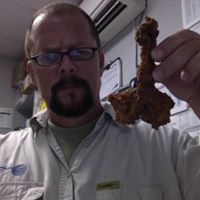Leaderboard
Popular Content
Showing content with the highest reputation on 10/13/2009 in all areas
-
Welcome! Man, I can't remember that last time we had any type of virgin here! Dive in, participate, have a good time, learn, teach, explore. Good luck. Dwayne2 points
-
It's certainly encouraging to see so many people advocating for adequate pain management in the prehospital setting. Rarely in our QA process are we "dinged" for giving too much pain medication but we are quickly informed if we haven't given enough. It is also encouraged to give it IM if you are having trouble obtaining an IV or it is taking a while to get one. I like to give a dose before we even transport the patient to the helicopter and I will usually give a dose or encourage the patient to accept pain medication just before we unload them out of the aircraft and into the ER. I know that there are going to be bumps with the multiple movements involved and then when they turn the pt and are completing their assessments in the ER. The only time I am really cautious about giving narcotics is if the patient is in extremis and I know their BP won't tolerate even a small dose. It helps to think that at least if they are at that point they probably aren't feeling a lot of the pain anyway. Better alive and in some pain then totally losing their BP. In these circumstances sometimes the few catecholamines they have floating around are all that is keeping them alive and if you take them away with narcotics they just crump and die. As has already been mentioned, Dr's should not be basing treatments on their physical assessments alone and this includes abdominal pain and head injuries (the diagnoses most often undertreated for fear of interfering with accurate diagnosis). If they are suspecting a fracture or an injury they are going to do additional x-rays, scans and lab tests anyway. And a patient's perception of pain is totally individual and quite often not that reliable to diagnose major injuries. I have had pt's with multiple fractures/major injuries who look atraumatic say that they have no pain or very little pain. Then you get the patients with 10/10 pain who end up having nothing at all wrong with them except minor aches and pains. I always take into consideration the verbal and the non-verbal cues and always take at face value what the pt states the pain is. We had a lady with a pelvic fracture among other injuries who said her pain was severe but she didn't receive much pain meds because the provider thought she was too calm (lying there quietly with her eyes closed) and didn't think she was really in pain. Here is an article written by a nurse on the physiological response of pain. One main point I think is that pain causes increased oxygen consumption and in sick and traumatized pts we really need to be minimizing this. I enjoyed all the other articles posted and found the Dr BledsoeJEMS one very useful for teaching purposes. Thank you all for a great discussion.2 points
-
I ran a call last night in which a bicyclist and a car collided at an intersection at a low rate of speed. By low, I mean the car had traveled three feet from a dead stop before coming in contact with the bicyclist. The speed would have likely been well below 5 mph. The patient was alert, oriented, and had a complaint of "a tired feeling" in his lower thoracic spine area. He had some minor redness to this area that resembled his mesh undershirt. He was ambulatory at the scene and initially wanted to refuse treatment and transport. He had no distracting injuries, no c-spine tenderness, no neurological deficits, no loss of consciousness, and was wearing a helmet as well as a few layers of protective clothing. He states he more or less tipped onto the hood of the car landing on his back. He was NOT thrown into the air, and had contact with the car that probably had less impact than if he would have fallen to the ground from a standing position. No damage to the car or the bike. His vital signs remained well within his normal limits throughout transport. We did not immobilize the patient. My third rider felt the patient didn't require spinal precautions and I agreed based on all the information I gathered. When we got to the ER and gave report to one of the residents, he ordered spinal precautions on the patient. The nurse also decided to give my third rider a hard time over not taking precautions. I'm telling this story because I started researching c-spine clearance criteria when I got home this morning in an attempt to figure out if I had mis-managed my patient. I'm familiar with the NEXUS criteria, and honestly, that his the criteria I cited in my rational for not taking precautions. This morning I came across a few abstracts about the Canadian c-spine rule and how it is superior to NEXUS criteria. In turn, I researched the Canadian c-spine rule and reclassified my patient based on that criteria while doing a little call review with myself. After all of that, here is my question (finally ): Would this particular case be consistent with the "bicycle struck or collision" part of the dangerous mechanism? I understand it technically was a bicycle collision, but this man probably would have hurt himself more falling to the ground. The car hood likely broke his fall from the bike and probably kept him from more significant injuries. Secondly, how many of you would or would not have immobilized the above patient and why? I know the outcome of the patient, and I'll post it after some feedback. Thank you all for your help.1 point
-
So I used more pain meds on my patients last month than any of our other Paramedics. But as primary job is within 10 minutes to the hospital the director of nurses and me had a not so polite discussion about me interfering with doctors assessments of patients because I do pain management. The nurse said unless more than 15 minutes out I should not give pain meds. I told her my patients health and comfort come first not the doctors convenience and that any doctor that knows their job can still properly assess a patient that has been given pain meds. Plus if it seems to be hindering they can reverse the affects. So was I wrong? Would you withhold pain management? Also I am fully in compliance with my medical directors pain management guidelines, so this is not me being a rogue medic.1 point
-
Hmm let's see - high desert, people not acclimatized to high desert, sitting crowded in a dark, overheated, confined area, after in all likelihood, physical activity they are not accustomed to, eating food they are probably not accustomed to, led by self proclaimed experts in "spiritual", "holistic" and "alternate" therapies... What could possibly go wrong?1 point
-
We don't have to. The advertisers have probably seen the Nielsen Ratings posted this morning. It came in below Heroes which is pretty bad. Probably the only ones watching this show are those in EMS who want to see just how bad it is or the young and enthusiastic POV light bar collectors. The rest of the viewing public don't seem to be wasting their time.1 point
-
I had the same thought last night Micheal. Problem was, as soon as they popped the kid with Narcan IM, I had to excuse myself to the restroom and never turned the channel back. I tried to watch episode 3 with my wife, an OR nurse who admittedly knows "nothing" about prehospital medicine. We watched the first 10 minutes or whatever than changed the channel to "Dancing with the Stars". My misses commented that it was stupid and really, really bad acting, which is my biggest beef with this show. I could sluff off the inaccuracies in treatment if it was entertaining! Somehow, watching Donnie Osmond doing the "Charleston" was more entertaining than Trauma.1 point
-
Friend posted this story to me, and it made me feel sick to my stomach! These guys better fry for this. http://www.courthousenews.com/2009/09/23/Family_Says_911_Tape_Caught_Cops_Planning_Cover-Up_After_Shooting.htm?=protectandserve PHOENIX (CN) - A homeowner says a Phoenix police officer shot him six times in the back during a 911 home-invasion call, and the 911 tape recorded the officer's partner saying, "That's all right. Don't worry about it. I got your back. ... We clear?" The family says the officers were not aware that the 911 call was still recording as they spoke about covering up the shooting. In their complaint in Maricopa County Court, Anthony and Lesley Arambula say an armed intruder "crashed through the front window" of their home on Sept. 17, 2008 and ran into one of their son's bedrooms. Anthony, worried about his son who was still in his bedroom, says he "held the intruder calmly at gunpoint" and called 911. Phoenix Police officers already in the neighborhood heard the crash of the Arambulas' window. When they approached the house, Lesley says, she told Sgt. Sean Coutts that her husband was inside holding the intruder at gunpoint. Lesley says Coutts failed to pass on that information to the two other officers. Inside the house, the Arambulas say, Officer Brian Lilly shot Anthony six times in the back while he was still on the phone with the 911 operator - twice when he was on the ground. The officers ran into the bedroom after Anthony told them, "You just killed ... you just killed the homeowner. The bad guy is in there." The complaint states that Officer Lilly "admitted that it was only after Tony was laying, bullet-ridden, on the ground that he assessed the situation. The 911 tape continued to record what happened even after Officer Lilly unloaded his weapon into Tony, including Officer Lilly's post-shooting, one-word 'assessment': 'Fuck.' "Tony believed he was going to die; the 911 tape records his plaintive goodbye to his family: '... I love you ... I love you.' Then Tony made what he believed was a dying request to the officers; he did not want his young family to see him shot and bloodied. Officers callously ignored his request and painfully dragged Tony by his injured leg, through the home and out to his backyard patio, where they left him bloodied and shot right in front of Lesley, Matthew and Zachary." The Arambulas say the officers later dragged Anthony onto gravel, then put him on top of the hot hood of a squad car, and "drove the squad car down the street with Tony lying on top, writing in pain." According to the complaint, Lilly can be heard on the 911 tape telling Coutts, "We fucked up." Lilly says on the tape that he did not know where Anthony's gun was when he shot him and that he "opened fire because he heard loud noises and saw someone who looked like he might be the 'Hispanic' male they were pursuing" before getting to the Arambulas' house, according to the complaint. The complaint states: "Sgt. Coutts knew that officers has just shot up and likely killed an innocent homeowner and the husband of Lesley, with whom he had spoken before entering the home, instead of the armed intruder. Sgt. Coutts was quick to commence the cover-up of their terrible mistake. Sgt. Coutts asked Office Lilly where Tony's gun was at the time Officer Lilly had opened fire on Tony. Officer Lilly admitted that he did not know where Tony's gun was: 'I don't know. I heard screaming and I fired.'" Lilly later told a police internal affairs investigator that Anthony had pointed his gun in his direction, "in the 'ready' position," the complaint states. But Anthony Arambula says he was facing away from the officers, who could not have even seen his gun. The complaint continues: "Still not knowing that he is being recorded n the 911 tape, Sgt. Coutts interrupted Officer Lilly's admission and apology with his assurance that the cover-up would commence: 'That's all right. Don't worry about it. I got your back. ... We clear?'" After the shooting, the Arambulas say, the Phoenix Police Department treated them "like suspects in a drug bust," denying Lesley, Michael and Zachary information about Anthony's condition and denying friends and family members access to him at the hospital. Anthony Arambula survived, but continues to suffer pain, which he expects will last for the rest of his life. The City of Phoenix and Officer Dzenan Ahmetovic also are named as defendants. The Arambulas seek punitive damages for gross negligence, civil rights violations, failure to supervise, excessive force, deliberate indifference to medical needs, false arrest, and emotional distress. They are represented by Michael Manning with Stinson Morrison Hecker.1 point
-
1 point
-
I am familiar with sailnet and we belong to the 7 seas cruising association, which is where I got a basic kit list from and we're going off of it. The ACEP is a great resource and I will look into it. A local hospital in D.C. GW to be exact does the cruise line base hospital deal so I was thinking of asking one of their docs about stuff as well. Ty for your help!1 point
-
Nope, not just you. Did CPR on a 6-yo drowning victim for almost 2hrs a couple months ago (calling TOD was complicated) and I can still see her eyes, bright blue. A nurse finally taped them shut, she said to keep them from getting dry, but I think it was bothering her even more than me.1 point
-
1 point
-
I along with many preceptors in my area feel the woes of "The Student". I feel 100% as a preceptor is is your job to mold them into EMT's or Paramedics - what ever they are training to be but........... I know EMTs have little to no road knowledge and skills so remember when you started and mold them accourding to current standards and give them a break.... As far as the Paramedic student....well...... We have found a growing trend in our area that these programs will take someone onboard into a program to further educate them to an ALS level but the instructors are now money based...when I was a student back oh 10+years ago you had to have a minimum of 5yrs city, commercial or very very busy Volunteer experience. Today we have had many students come through that went from EMT directly to Paramedic with no ambulance time....this causes a huge problem for preceptors trying to train the BLS skills throught the ALS skills. So YES we have a lot of woes but I think a standard of time needs to be put in place by both a state and national level to have a minimum time on an ambulance prior to even starting a paramedic progam.1 point
-
I am very proactive in controlling patients pain and I'm sorry if that ticks off the docs a bit, but I'm going to within my ability to do so and providing the patient is stable enough to allow it. Every patient is different so that would influence how far out I gave pain meds (within the 5 minute category). I think to withold pain medication is not only cruel but compromises patient care - pain increases heart rate, anxiety, among other things. If you can reduce that don't you see positive effects from it? As to the being close to the ER, well, I'm going to go ahead and give meds if the patient warrants it because our ER's around here are almost always overcrowded and it takes the docs a bit to get around to see a patient sometimes. Sometimes it's even a bit before someone comes in to assess them (the nurses sign paperwork, ask for vitals, and leave). If they already have some pain control on board then it helps them wait out those long minutes. From a patient perspective, I can say I've appreciated the few times I've received pain meds due to a few significant injuries I've had. It was one of the kindest things they could do. It at least took it from being almost unbearable to just discomfort which I could more than live with. Old people I've found are some of the most reluctant to take pain meds as most have been raised with the "suck it up" mentality, and younger people the most willing. That's solely an observation and much of it depends on the patient's prior experience with pain. If the worst thing they've had is a stubbed toe, then obviously a broken arm is going to be unbearable and if the opposite is true, then they will have a greater pain tolerance (which varies from person to person as well). I hardly think you are overstepping appropriate patient care Spenac - you have put your patients care and comfort first, and I'm sure they thank you for it. You already knew your answer as others stated and I give you for your treatment of your patients. If a nurse fusses at you again, just calmly ask - if you were in this position wouldn't you want some analgesia? I'm pretty sure their answer would be yes. It's not cruel and it got alot of people in our area to change their mind set. Most don't want to give to due lack of convenience, it's one more thing they have to give, one more thing to chart. But when you flip the coin and get them to thinking about it being them, most will soften. Continue your compassionate care (wait did I just say that to spenac?) and always stay safe.1 point
-
So, to add to this conversation. It looks like there is some good news and bad new out about H1N1. It looks like it is starting to come back (with a vengence perhaps). Total influenza hospitalization rates for laboratory-confirmed influenza are higher than expected for this time of year for adults and children. And for children 5-17 and adults 18-49 years of age, hospitalization rates from April – October 2009 exceed average flu season rates (for October through April). The proportion of deaths attributed to pneumonia and influenza (P&I) based on the 122 Cities Report has increased and now exceeds what is normally expected at this time of year. In addition, 19 flu-related pediatric deaths were reported this week; 16 of these deaths were confirmed 2009 H1N1 and 3 were unsubtyped influenza A and likely to be 2009 H1N1. A total of 76 laboratory confirmed 2009 H1N1 pediatric deaths have been reported to CDC since April. The good news is: Almost all of the influenza viruses identified so far are 2009 H1N1 influenza A viruses. These viruses remain similar to the virus chosen for the 2009 H1N1 vaccine, and remain susceptible to the antiviral drugs oseltamivir and zanamivir with rare exception. This is taken from http://cdc.gov/h1n1flu/update.htm Though I don't think the immunization should be mandatory, I will be getting mine, as will my family.1 point
-
Anyone in a position to precept students should have a very clear understanding of what both the preparations and expectations of the preceptorship are. Different programmes have different set-ups. Some schools integrate students into the field early to get them early exposure and allow them to integrate education with training and observation. Others do it step by step, not sending them to the field until they have all of their didactic done. Both students will be at different levels of preparation. However, neither should be expected to be competent practitioners of ANYTHING. Expect nothing. Teach them everything. That's your job. If they knew it all, they wouldn't need you.1 point
-
So if I majikally lose 5 reputation points every night after the counter resets... I guess that means I permanently pissed off an elite member, right?1 point
-
This looks mighty useful for rescue situations where bagging the patient is very difficult, much less regular bagging. Sometimes bagging is even a hindrance to extrication (think confined space, MVC entrapment, high angle, wilderness).1 point
-
Since someone asked, my little example is a summary of exactly what happened in a county near me. Crazy but true!1 point
-
I had a 4th year student from COMP in the ER last week doing his EM elective and was quite impressed with him. The students from that school in California seem quite good (at least in the ED at UMC). It's called parody. Month Python made their fortune doing it.1 point
-
PART 2: Commissioner: Not anytime soon. Fire Chief: Fine. I'll buy some ambulances out of my current budget and staff them with fire medics. Commissioner: You don't have a transport license. Fire Chief: Yes, but eventually you'll have to give me one or the public will wonder why YOU are stopping the FD from saving lives. (This is why Fire will always win)1 point
-
A DIFFERENT PERSPECTIVE: County commissioner: So there were 4 structure fires in your district last year and you didn't even save any of the foundations. You have 3 stations staffed 24 hour with 75 full time paid FFs on payroll. You have $10 million dollars of apparatus, three expensive buildings, and a Godzilla sized personnel budget. Why on earth is the district giving you this much money? You guys barely do any fire fighting and when you do, you fail! Fire Chief: Over the last few years I made all of my Firefighters into EMTs and we respond to all medical calls! And car wrecks too! My people could save your life, commissioner! County commissioner: So you are doing what the ambulance service already does? Except they take people to the hospital. And they only have two small stations and 20 full time paramedics and $1 million in apparatus and they are mostly self supporting because they can bill their patients. They are very busy. Fire Chief: We usually beat ambulance to the scene by 30 seconds! I'm also starting to hire paramedics to offer better care for those 30 seconds we are there before the ambulance. We can make money too if you let us transport patients! You should buy us a couple of ambulances! County commissioner: You want more money??? Besides, that would put the ambulance service out of business! Fire Chief: You know, that's a great point. You don't really need them. You HAVE to have a fire department. The district has got to pay for us. Look, there is a solution here. Let us take over EMS! I'll just make all my firefighters into paramedics ASAP. That will help you sell this to the voters. When can I expect delivery of my new ambulances?1 point
-
Explain to him that the problem is NOT the FF-EMTs or FF-Medics, it is the Fire management and the bean counters. Management wants EMS call volume and income to subsidize and justify the fire side where calls are down thanks to building codes lobbied for by Fire. Part of that plan is to quickly and easily make and keep as many FFs as EMTs/Medics as quickly and easily as possible. Increasing the barriers for their FF's (who they want to wear many hats) to become and remain medics by increasing education standards is not in their plan. The line Firefighters are usually plenty professional. I think most Fire EMS people who actually want to do EMS (and there are plenty who don't want to do EMS) are people with no problem with increased education as long as they get out of it what they put into it (in opportunity and pay for time). However, most Fire Management isn't that interested. They are FIRE Management, right? Remember, it is Fire-EMS, not EMS-Fire. Nevermind which side gets more volume.1 point
-
Agreed about how poorly this story was written. Apparently journalism schools have seriously dropped their standards. As to the cops who f'ed up- bad news. I am the first to defend LEO's and give them the benefit of the doubt, BUT... Everyone makes mistakes, but my gawd. Even if it WAS the bad guy they shot multiple times, dragging someone outside by the leg, onto gravel and throwing them on the hood of the car? WTF are these clowns thinking?1 point
-
Sometimes you are merely checking for the presence of breath sounds. In such cases, sometimes (depending on the patient), environmental factors may make it preferential to auscultate through clothes if you can (you can do the real auscultations in the ambulance). EMT-B's especially are rarely well trained in identifying breath sounds anyways. Overall, yes. Big problem in EMS. (especially failure to expose for trauma... I've seen chest trauma treated as an AMI when a simple shirt lift would have showed massive contusions.1 point
-
Umm... how bout using a new neb each time? What's the problem here? IV ventolin? For respiratory? Sounds less effective and more dangerous...1 point
-
In order from most pain in the butt to least pain in the butt to deal with: Red Cross AHA ASHI0 points
-
Trauma portrays us as unprofessional sex crazed sexist adrenaline junkies... THAT'S BAD! That video portrays Adolf Hitler, the worst villain in history, as the head of EMS and Bledsoe, RidRyder, and dustdebil as his Nazi generals... THAT'S FUNNY? Uhh.... alrighty then... I'm with Kiwimedic (but I'm not going to waste good booze) However, Downfall was very well done movie. http://www.downfallthefilm.com/0 points
-
Don't do it! You don't need training and experience to become a competent diagnostician. You need EDUCATION! You will get 100 times more benefit out of a semester of college Anatomy & Physiology than you would out of five years as an EMT-I. Your I training was a complete waste of time. I experience will be equally useless. Experience does not have optimum benefit on your practice until it has a theoretical foundation from which to grow. And the only place to get that theoretical foundation is back in school. The longer you wait to do that, the less of a medic you will ultimately be.-1 points
-
I've always been taught that femur fracture = c-spine. If it's strong enough to break the femur, the trauma docs want the patient immobilized until a CAT scan is done. But I digress.-1 points
-
A c-spine wouldn't necessarily be a bad thing in the case of a femur fracture. If the patient experienced enough force to break his femur, the spine could very well be damaged. I learned that off Trauma.-1 points
-
Well im a little more than half way through my emt class and really tryin to get my butt on an ambulance even if it's just one day a week so i can start gettin some real world experience. It doesnt seem to be going to good so far im assumeing cuz i dont have for my certification yet but i really wanna start running, anybody got any tips on getting through the door?-1 points
-
thanks for the offer but i kept at it and i just got in at central pocono in tannersville i live in monroe county in northeastern pa i start weds nite thanks for the advice i kept at it and got in!-1 points
-
-1 points













